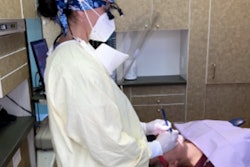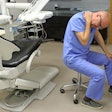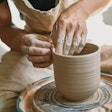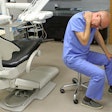If you’re a dental professional dealing with tight, rock-hard upper traps, you’re far from alone. The upper trapezius muscles are notorious for becoming overworked and fatigued, especially in dentistry, where repetitive movements and awkward positioning are part of the daily routine.
Let’s break down three of the most common culprits behind those concrete traps and how you can finally get some relief.
The mirror arm “chicken wing”
Ever catch yourself flaring your elbow out like a wing while using your mirror? You're not imagining it -- this “chicken wing” posture is one of the most common ergonomic issues I see during assessments, particularly on the nondominant side.
Why it happens
- You’re holding the mirror too high on the handle.
- The patient isn’t positioned correctly.
What to try instead
- Adjust your grip. Hold the mirror closer to the mirror head to naturally drop your elbow and relax your shoulder. You can see this technique in action in the video below.
Use a fulcrum. Rest your fingers on the patient’s face or teeth for better control and less strain.
Excessive reaching = excessive tension
If you’re frequently reaching across the operatory -- whether for your suction, air/water syringe, or materials -- your traps are likely paying the price. Full arm extension causes repeated muscle contraction, which adds up to tension, fatigue, and wasted energy.
 Tray setup and positioning can be key to reducing chronic muscle strain in dental professionals.Stephanie Botts, RDH.
Tray setup and positioning can be key to reducing chronic muscle strain in dental professionals.Stephanie Botts, RDH.
Ergonomic tip
- Set up your operatory with intention.
- Keep essentials like your bracket table, suction, and air/water syringe within easy reach.
- Avoid overreaching by repositioning your tools just a few inches closer.
Small shifts in your setup can lead to big relief.
Poor patient positioning
It may seem like a minor detail, but positioning your patient even slightly too high can wreak havoc on your posture. When the patient’s mouth sits above your elbow, your arms are forced to elevate and abduct, activating the traps all over again.
Quick fix
Make sure the patient’s mouth aligns with your elbow height when you're seated neutrally. This small change gives your nondominant arm a well-deserved break and sets you up for better ergonomics throughout the day.
Bonus: Build in microbreaks
Even the best posture won’t save you if you stay frozen in one position all day. Microbreaks give your muscles oxygen, reset your posture, and offer much-needed mental relief.
Try this formula
- Take a 20-second break every 20 minutes.
- Incorporate deep breathing for added relaxation.
Let’s wrap it up
You don’t have to accept tight traps as a job hazard. With a few strategic changes -- like mastering mirror technique, optimizing your operatory setup, fine-tuning patient positioning, and remembering to take breaks -- you can protect your body and extend your career.
Stephanie Botts, RDH, has been a clinical dental hygienist for more than 17 years. She is a certified ergonomics assessment specialist who provides in-office and virtual ergonomics consulting and coaching to dental professionals. She also provides continuing education to dental and dental hygiene associations on the topic of ergonomics. She can be reached at [email protected] or on Instagram at @steph.polishedposture.
The comments and observations expressed herein do not necessarily reflect the opinions of DrBicuspid.com, nor should they be construed as an endorsement or admonishment of any particular idea, vendor, or organization.



















